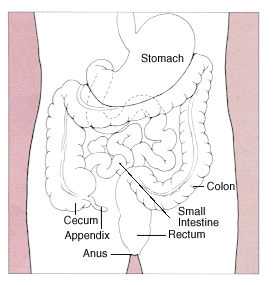Colon (anatomy): Difference between revisions
→Colon subsections of Note: Hmm, what to do about the subsections |
→Colon Subsections: Cecum added |
||
| Line 31: | Line 31: | ||
==Colon Subsections== |
==Colon Subsections== |
||
===Cecum=== |
|||
The '''cecum''' or '''caecum''' is a pouch connected to the large [[intestine]] between the [[ileum]]. It is separated from the ileum by the [[ileocecal valve]] (ICV) or Bauhin's valve, and is considered to be the beginning of the large intestine and part of the colon. |
|||
The cecum is present in [[mammal]]s, [[bird]]s, and some [[reptile]]s. Most [[herbivore]]s have a relatively large cecum, and exclusive [[carnivore]]s have a smaller cecum or none at all. This size difference results from the large number of [[bacterium|bacteria]] in the cecum of herbivores, which aid in the [[enzyme|enzymatic]] breakdown of plant materials such as [[cellulose]]. Carnivores, whose diets contain little or no plant material, have a reduced cecum, often partially or wholly replaced by the [[vermiform appendix]]. |
|||
The [[Vermiform appendix|appendix]] is a branch of the cecum. Like the appendix, the cecum (from the [[Latin]] ''caecus'' meaning ''blind'') was once believed to have no function. |
|||
===Sigmoid colon=== |
===Sigmoid colon=== |
||
[[image:Intestine.png|thumb|right|Diagram of the Human Intestine]] |
[[image:Intestine.png|thumb|right|Diagram of the Human Intestine]] |
||
Revision as of 20:42, 14 January 2006

In anatomy of the digestive system, the colon, also called the large intestine or large bowel, is the part of the intestine from the cecum to the rectum. Its primary purpose is to extract water from feces. In mammals, it consists of the cecum, ascending colon, transverse colon, the descending colon, the sigmoid colon, and the rectum. The colon from cecum to the mid transverse colon is also known as the right colon. The remainder is known as the left colon.
Role in digestion
The large intestine comes after the small intestine in the digestive tract and measures approximately 1.5 meters in length. Although there are differences in the large intestine between different organisms, the large intestine is mainly responsible for storing waste, reclaiming water, maintaining the water balance, and absorbing some vitamins, such as vitamin K.
By the time the chyme has reached this tube, almost all nutrients and 90% of the water have been absorbed by the body. At this point some electrolytes like sodium, magnesium, and chloride are left as well as indigestible carbohydrates known as dietary fiber. As the chyme moves through the large intestine, most of the remaining water is removed, while the chyme is mixed with mucus and bacteria known as gut flora, and becomes feces. The bacteria break down some of the fiber for their own nourishment and create acetate, propionate, and butyrate as waste products, which in turn are used by the cells lining of the colon for nourishment. This is an example of a symbiotic relationship and provides about 100 Calories a day to the body. The large intestine produces no digestive enzymes — chemical digestion is completed in the small intestine before the chyme reaches the large intestine. The pH in the colon varies between 5.5 and 7 (slightly acidic to neutral).
Diseases of the colon
- angiodysplasia of the colon
- colitis
- colon cancer
- constipation
- Crohns disease
- diarrhea
- diverticulitis
- Hirschsprung's disease (aganglionosis)
- polyposis (see also Polyp)
- pseudomembranous colitis
- ulcerative colitis and toxic megacolon
Disorders of the colon
Irritable Bowel Syndrome, also known as spastic colon or spastic bowel, is the most common functional disorder of the intestines, but it is actually a motility disorder of both small bowel and colon. Functional Constipation and Chronic Functional Abdominal Pain are other disorders of the colon that have physiological causes, but do not have identifiable structural, chemical, or infectious pathologies.
Colon Subsections
Cecum
The cecum or caecum is a pouch connected to the large intestine between the ileum. It is separated from the ileum by the ileocecal valve (ICV) or Bauhin's valve, and is considered to be the beginning of the large intestine and part of the colon.
The cecum is present in mammals, birds, and some reptiles. Most herbivores have a relatively large cecum, and exclusive carnivores have a smaller cecum or none at all. This size difference results from the large number of bacteria in the cecum of herbivores, which aid in the enzymatic breakdown of plant materials such as cellulose. Carnivores, whose diets contain little or no plant material, have a reduced cecum, often partially or wholly replaced by the vermiform appendix.
The appendix is a branch of the cecum. Like the appendix, the cecum (from the Latin caecus meaning blind) was once believed to have no function.
Sigmoid colon

The sigmoid colon is the part of the large intestine after the descending colon and before the rectum. The name sigmoid means S-shaped (see sigma). The walls of the sigmoid colon are muscular, and contract to increase the pressure inside the colon, causing the stool to move into the rectum.
Due to the intermittent high pressure within it, the colon can develop pockets called diverticuli in its walls. The presence of diverticuli, whether harmful or not, is called diverticulosis. An infection of the diverticuli is called diverticulitis.
Sigmoidoscopy is a common diagnostic technique used to examine the sigmoid colon.
If long objects are inserted forcibly into the anus, the rectum or sigmoind colon may be damaged.
